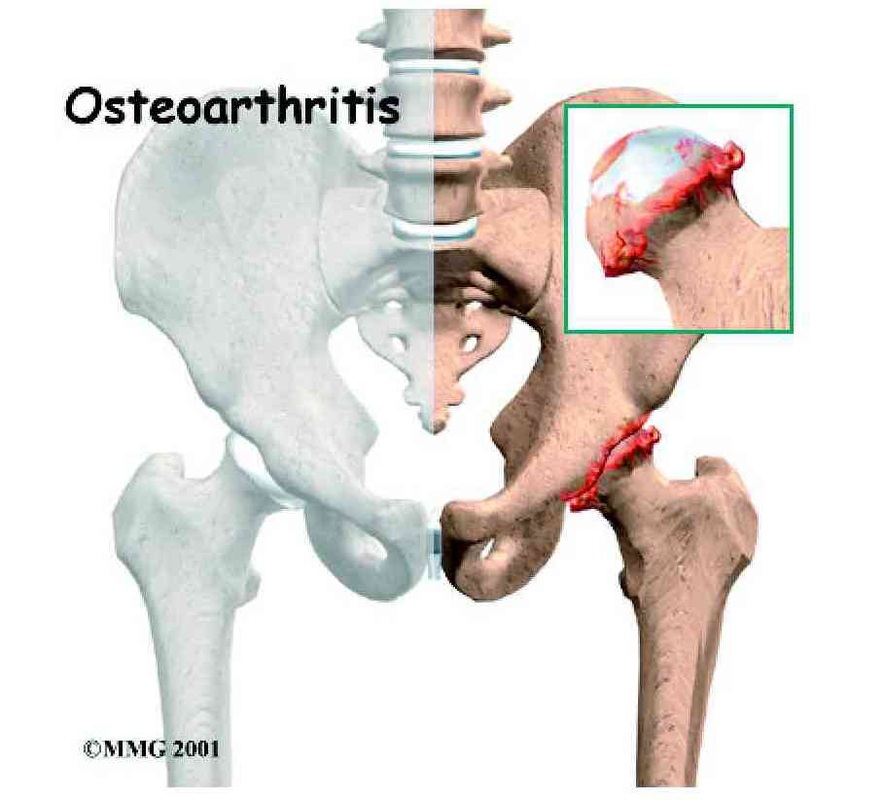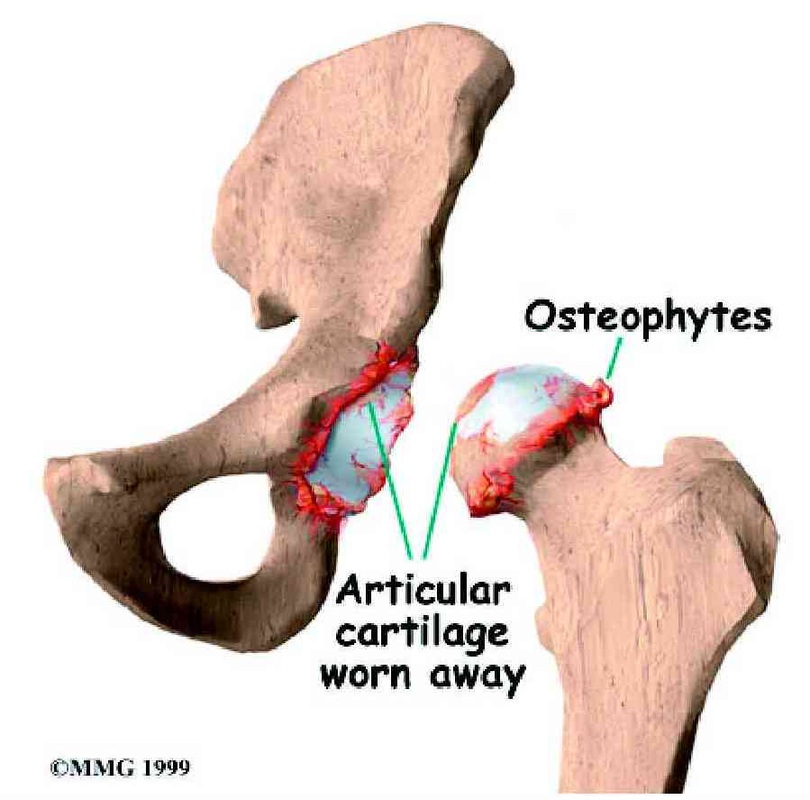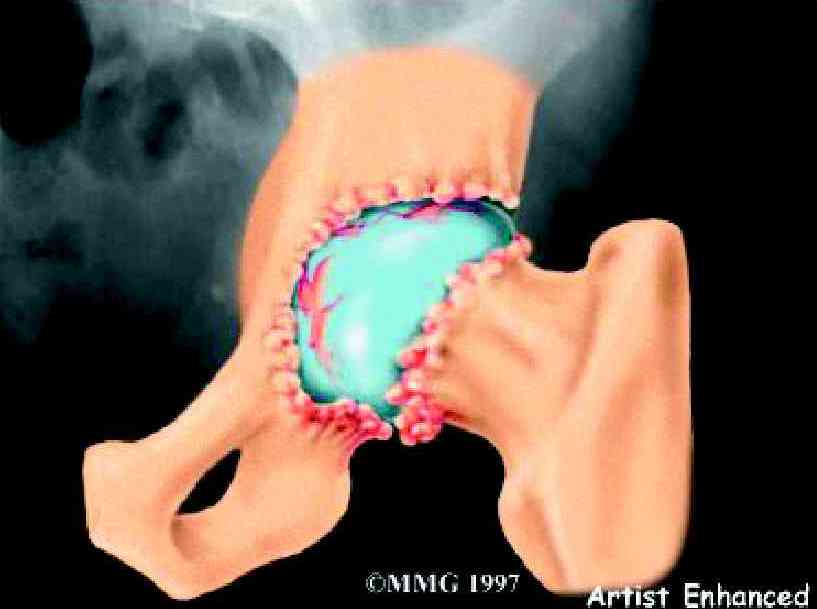Hip Arthritis Information
Omaha Hip Arthritis Information by Dr. Ajoy Jana MD
Arthritis refers to any condition that results in the breakdown or degeneration of joint cartilage. There are many types of hip arthritis. The most common types of arthritis include:
- Osteoarthritis (OA), also known as degenerative joint disease (DJD), is the most common type of arthritis. Although OA is typically thought to result from years of wear-and-tear, science does not yet have a complete understanding of this disease. Being overweight greatly increases the likelihood of developing OA. Genetics play an important role, since OA clearly runs in families. However, it remains unknown why OA affects some people in their 40’s and others in their 80’s, or why it often affects only one hip.
- Rheumatoid arthritis (RA) is an auto-immune disease and a type of inflammatory arthritis that causes severe inflammation of the lining (synovium) of the joint, which causes destruction of the joint cartilage. It is the second most common cause of joint degeneration. Other auto-immune diseases such as psoriasis, lupus and Crohn's disease are also associated with inflammatory arthritis. RA usually effects multiple joints and it is the second most common cause for hip replacement.
- Post-traumatic arthritis occurs when joint cartilage is directly injured and then deteriorates over time.
- Osteonecrosis, also known as avascular necrosis, occurs when the blood supply to the head of the femur is disrupted. Without enough blood flow the bone dies and collapses, resulting in both pain and eventual degeneration of the overlying cartilage.
- An abnormally shaped hip ball or hip socket can cause early arthritis. This may result from hip problems present from birth such as Developmental Dysplasia, or during childhood and adolescence such as Perthes Disease and Slipped Capital Femoral Epiphysis.
Osteoarthritis of the Hip
Introduction
Osteoarthritis (OA) is a common problem for many people after middle age. OA is sometimes referred to as degenerative, or wear-and-tear, arthritis. OA commonly affects the hip joint. In the past, little was done for the condition. Now doctors have many ways to treat hip OA so patients have less pain, better movement, and improved quality of life. Which part of the hip does OA affect? Articular cartilage is the smooth lining that covers the surfaces of the ball-and-socket joint of the hip. The cartilage gives the joint freedom of movement by decreasing friction. The layer of bone just below the articular cartilage is called subchondral bone. The main problem in OA is degeneration of the articular cartilage. When the articular cartilage degenerates, or wears away, the subchondral bone is uncovered and rubs against bone. Small outgrowths called bone spurs or osteophytes may form in the joint. How does OA develop? OA of the hip can be caused by a hip injury earlier in life. Changes in the movement and alignment of the hip eventually lead to wear and tear on the joint surfaces. The alignment of the hip can be altered from a fracture in the bones around or inside the hip. If the fracture changes the alignment of the hip, this can lead to excessive wear and tear, just like the out-of-balance tire that wears out too soon on your car. Cartilage injuries, infection, or bleeding within the joint can also damage the joint surface of the hip. Not all cases of OA are related to alignment problems or a prior injury, however. Scientists believe genetics makes some people prone to developing OA in the hip. Scientists also believe that problems in the subchondral bone may trigger changes in the articular cartilage. As mentioned, the subchondral bone is the layer of bone just beneath the articular cartilage. Normally, the articular cartilage protects the subchondral bone. But some medical conditions can make the subchondral bone too hard or too soft, changing how the cartilage normally cushions and absorbs shock in the joint. Avascular necrosis (AVN) is another cause of degeneration of the hip joint. In this condition, the femoral head (the ball portion of the hip) loses a portion of its blood supply and actually dies. This leads to collapse of the femoral head and degeneration of the joint. AVN has been linked to alcoholism, fractures and dislocations of the hip, and long-term cortisone treatment for other diseases. What does OA of the hip joint feel like? The symptoms of hip OA usually begin as pain while putting weight on the affected hip. You may limp, which is the body's way of reducing the amount of force that the hip has to deal with. The changes that happen with OA cause the affected hip to feel stiff and tight due to a loss in its range of motion. Bone spurs will usually develop, which can also limit how far the hip can move. Finally, as the condition becomes worse, pain may be present all the time and may even keep you awake at night. |
|
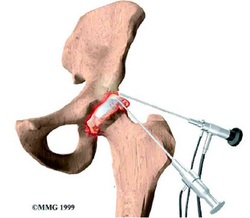
How do doctors identify the problem?
The diagnosis of hip OA starts with a complete history and physical examination by your doctor. X-rays will be required to determine the extent of the cartilage damage and suggest a possible cause for it. Other tests may be required if there is reason to believe that other conditions are contributing to the degenerative process. Magnetic resonance imaging (MRI) may be necessary to determine whether your hip condition is from problems with AVN. Blood tests may be required to rule out systemic arthritis or infection in the hip.
What can be done for the condition?
Nonsurgical Treatment - OA can't be cured, but therapies are available to ease symptoms and to slow down the degeneration of the joint. Recent information shows that your condition may be maintained and in some cases improved.
The diagnosis of hip OA starts with a complete history and physical examination by your doctor. X-rays will be required to determine the extent of the cartilage damage and suggest a possible cause for it. Other tests may be required if there is reason to believe that other conditions are contributing to the degenerative process. Magnetic resonance imaging (MRI) may be necessary to determine whether your hip condition is from problems with AVN. Blood tests may be required to rule out systemic arthritis or infection in the hip.
What can be done for the condition?
Nonsurgical Treatment - OA can't be cured, but therapies are available to ease symptoms and to slow down the degeneration of the joint. Recent information shows that your condition may be maintained and in some cases improved.
- Exercise: Keep your muscles strong and maintain your flexibility to decrease arthritis pain. You should choose low impact exercises that you enjoy and can do without too much discomfort. Consider walking, cycling, water aerobics, swimming, or elliptical machines.
- Weight Loss: Losing weight has numerous health benefits including easier mobility.
- Medicines: Acetaminophen (Tylenol) is a good first choice for pain control, but limit yourself to 3000 mg per day to avoid risk of liver damage. Anti-inflammatory medications, such as Ibuprofen, Aleve, or Celebrex, are the second choice for most patients. It is important to inform your doctor if you are using any over-the-counter pain medication since all anti-inflammatory medications can raise blood pressure, increase water retention, and cause stomach ulcers. Narcotic pain killers such as Vicodin or Percocet are rarely used because they are habit-forming, have numerous side-effects and are indicated for short-term relief of pain.
- Supplements: Although Glucosamine and Chondroiton supplements are popular, most studies show minimal benefits. Fish Oil has been shown in some studies to help arthritis pain in addition to preventing heart disease.
- Shoe modifications: Comfortable, well-cushioned walking shoes can be helpful.
- Injections: Cortisone injections are rarely used to treat hip arthritis. They are difficult to give because of the anatomy of the hip and they do not provide long lasting relief. When indicated, any injections into the joint are best done under X-ray guidance by an interventional radiologist.
- Cane: Even though many people don't want to use support, using a cane or walker is one of the most effective ways to decrease pain and improve walking distance. Canes should be used in the hand opposite of the affected hip.
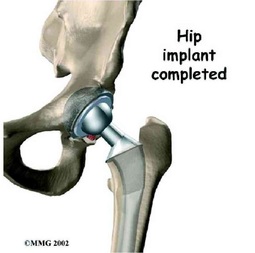
Surgical Treatments
- Arthroscopy - Surgeons can use an arthroscope to check the condition of the articular cartilage in a joint. An arthroscope is a miniature TV camera inserted into the joint though a small incision. While checking the condition of the cartilage, your surgeon may try a few different techniques to give you relief from pain. One method involves cleaning the joint by removing loose fragments of cartilage. Another method involves simply flushing the joint with a saline solution, after which some patients report relief. This procedure is sometimes helpful for temporary relief of symptoms. Hip arthroscopy is relatively new, and it is unclear at this time which patients will benefit.
- Osteotomy - When the alignment of the hip joint is alteredfrom disease or trauma, more pressure thannormal is placed on the surfaces of the joint. This extra pressure leads to more pain and faster degeneration of the joint surfaces.In some cases, surgery to realign the angles of the pelvic socket or femur (thighbone) canresult in shifting pressure to the other healthier parts of the hip joint. The goal is to spread theforces over a larger surface in the hip joint.This can help ease pain and delay further degeneration. The procedure to realign the angles in the joint is called osteotomy. In this procedure, the bone of either the pelvic socket or femur iscut, and the angle of the joint is changed. The procedure is not always successful. Generally it will reduce your pain but not eliminate it altogether. The advantage to this approach isthat very active people still have their own hip joint, and once the bone heals, there are fewer restrictions in activity levels. An osteotomy procedure in the best of circumstancesis probably only temporary. It isthought that this operation buys some time before a total hip replacement becomes necessary.
- Artificial Hip Replacement - When the treatments above fail, total hip replacement can provide excellent pain relief and, in most cases, return patients back to normal activities. Because of technological advances, hip replacements are lasting significantly longer than in the past. An artificial hip replacement is the ultimate solution for advanced hip OA. Surgeons prefer not to put a new hip joint in patients less than 60 years old. This is because younger patients are generally more active and might put too much stress on the joint, causing it to loosen or even crack. A revision surgery to replace a damaged joint is harder to do and has more possible complications.
Support Groups: Learn strategies for managing your arthritis from instructors and peers. Group education programs are available at the Arthritis Foundation, call or visit http://www.arthrits.org.
Connect with me on Google +
Parts of this document were reproduced with permission from eorthopod.com Osteoarthritis of the Hip Patient Guide


